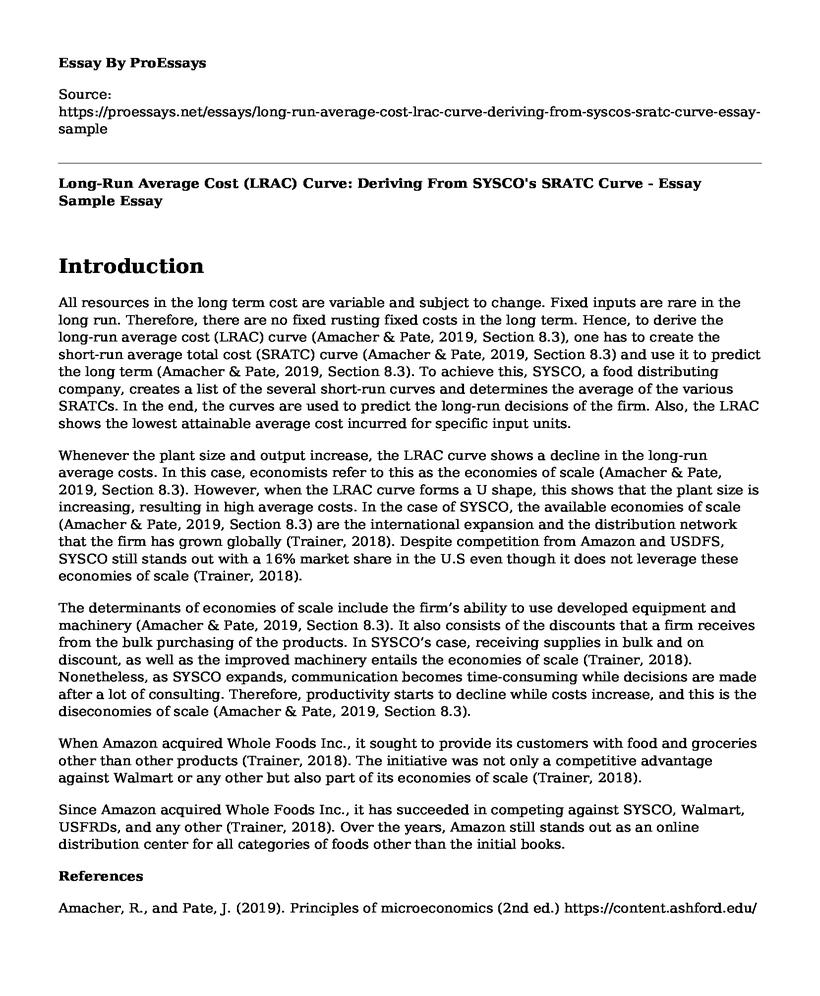Introduction
All resources in the long term cost are variable and subject to change. Fixed inputs are rare in the long run. Therefore, there are no fixed rusting fixed costs in the long term. Hence, to derive the long-run average cost (LRAC) curve (Amacher & Pate, 2019, Section 8.3), one has to create the short-run average total cost (SRATC) curve (Amacher & Pate, 2019, Section 8.3) and use it to predict the long term (Amacher & Pate, 2019, Section 8.3). To achieve this, SYSCO, a food distributing company, creates a list of the several short-run curves and determines the average of the various SRATCs. In the end, the curves are used to predict the long-run decisions of the firm. Also, the LRAC shows the lowest attainable average cost incurred for specific input units.
Whenever the plant size and output increase, the LRAC curve shows a decline in the long-run average costs. In this case, economists refer to this as the economies of scale (Amacher & Pate, 2019, Section 8.3). However, when the LRAC curve forms a U shape, this shows that the plant size is increasing, resulting in high average costs. In the case of SYSCO, the available economies of scale (Amacher & Pate, 2019, Section 8.3) are the international expansion and the distribution network that the firm has grown globally (Trainer, 2018). Despite competition from Amazon and USDFS, SYSCO still stands out with a 16% market share in the U.S even though it does not leverage these economies of scale (Trainer, 2018).
The determinants of economies of scale include the firm’s ability to use developed equipment and machinery (Amacher & Pate, 2019, Section 8.3). It also consists of the discounts that a firm receives from the bulk purchasing of the products. In SYSCO’s case, receiving supplies in bulk and on discount, as well as the improved machinery entails the economies of scale (Trainer, 2018). Nonetheless, as SYSCO expands, communication becomes time-consuming while decisions are made after a lot of consulting. Therefore, productivity starts to decline while costs increase, and this is the diseconomies of scale (Amacher & Pate, 2019, Section 8.3).
When Amazon acquired Whole Foods Inc., it sought to provide its customers with food and groceries other than other products (Trainer, 2018). The initiative was not only a competitive advantage against Walmart or any other but also part of its economies of scale (Trainer, 2018).
Since Amazon acquired Whole Foods Inc., it has succeeded in competing against SYSCO, Walmart, USFRDs, and any other (Trainer, 2018). Over the years, Amazon still stands out as an online distribution center for all categories of foods other than the initial books.
References
Amacher, R., and Pate, J. (2019). Principles of microeconomics (2nd ed.) https://content.ashford.edu/
Trainer, D. (2018, January 29). Sysco feasts on economies of scale for strong competitive advantage Forbes https://www.forbes.com/sites/greatspeculations/2018/01/29/sysco-feasts-on-economies-of-scale-for-strong-competitive-advantage/#26e40f74245e
Cite this page
Long-Run Average Cost (LRAC) Curve: Deriving From SYSCO's SRATC Curve - Essay Sample. (2023, Aug 28). Retrieved from https://proessays.net/essays/long-run-average-cost-lrac-curve-deriving-from-syscos-sratc-curve-essay-sample
If you are the original author of this essay and no longer wish to have it published on the ProEssays website, please click below to request its removal:
- Amazon Audit Report
- Lebanese Apples Inc. New Market Entry Paper Example
- The Impact of Management on Financial Performance: Apple under Jobs and Cook - Essay Sample
- Essay Example on Apple Inc.'s Marketing Strategies: Customers, Experience & Product Positioning
- Careem: Making Waves in the Technology & Vehicle Hire Industry - Essay Sample
- Report Sample on Amazon: From 'Get Big Fast' to Global Retail Giant
- Report Sample on Employment Laws in the COVID-19 Era







